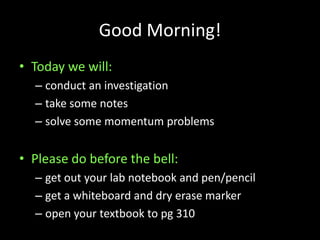
Conservation of Momentum
- 1. Good Morning! Today we will: conduct an investigation take some notes solve some momentum problems Please do before the bell: get out your lab notebook and pen/pencil get a whiteboard and dry erase marker open your textbook to pg 310
- 3. Warm-Up On your whiteboard, solve the following problem. SHOW GUTS! What is the momentum of a 0.3 kg cart moving at a velocity of 0.5 m/s?
- 4. Warm-Up #2 Identify the independent variable: What is the effect of increasing mass on objects with a constant momentum? Identify the dependent variable: (it’s NOT momentum)
- 5. Pre-Lab Please read pages 310 – 311 You are looking for: materials data you will be recording 5 minutes
- 6. Lab: Conservation of Momentum Open your lab book to the nearest clean page and title this lab, “Conservation of Momentum.” Be sure to make an entry into your Table of Contents as well.
- 7. Lab: Conservation of Momentum Groups of 5 – 6 Everyone writes down all data and answers in their lab book DURING the lab We will do Steps #1 – 3 in our lab
- 8. Lab: Conservation of Momentum In your lab book, identify the independent and dependent variable On your whiteboard, write an “if, then, because” hypothesis. Write a hypothesis in your lab book.
- 9. Data Table Following the directions on page 311, #1a, create a data table in your lab book that looks like the textbook’s. We will do SIX collisions. 7 minutes Create the data table you see on page 311, #3a. how many entries will this data table have? 5 min
- 10. Conservation of Momentum Momentum, like energy, is conserved. What does this mean for a car crash? In a car crash, if you add up all the momentum before a collision, it will equal the total momentum after a collision. Momentum BEFORE collision = Momentum AFTER collision
- 11. Conservation of Momentum Of course, there is a formula m1v1 + m2v2 = (m1 + m2)vf Why do we add the masses together after the collision? because they stuck together and travel at the same speed
- 12. Conservation of Momentum The conservation of momentum is true whether or not the objects “stick” together, however so the better formula might be: m1v1b + m2v2b = m1v1a + m2v2a Momentum Before = Momentum After
- 13. Law of Conservation of Momentum The total momentum beforea collision is equal to the total momentum afterthe collision if no external forces act on the system. this is true for all collisions between any objects! a car and a truck two railroad cars a proton and a proton a planet and a meteor
- 14. Conservation of Momentum Conservation of momentum is a crucial piece to understanding and predicting motion. Since we know the total momentum in the beginning of a collision, we know the total momentum after the collision. We can use this understanding to help us predict the results of any collision.
- 15. Sample Problem #1 pg 314 A 75 kg boy and a 50 kg girl are riding in identical bumper cars at an amusement park. The boy’s car is moving to the east at 3.00 m/s and the girl is moving west at a velocity of 1.80 m/s. If they stick together on collision, what is their final velocity?
- 16. Conservation of Momentum in Elastic Collisions What if the two objects don’t stick together, but move away in the same direction at different speeds? What formula should you use? m1v1b + m2v2b = m1v1a + m2v2a
- 17. Sample Problem #2 pg 315 A steel ball with a mass of 2kg is traveling 3 m/s west. It collides with a stationary ball that has a mass of 1 kg. Upon collision, the smaller ball moves to the west at 4 m/s. What is the velocity of the larger ball?
- 18. Checking In A vehicle with 6000 kgm/s of momentum collides with a car at rest. As they slide off together, what is their momentum?
- 19. Success Criteria Check P: Using the diagrams and the words “momentum, conservation of momentum, mass, velocity, and direction,” describe how we can predict the motion (speed and direction) of objects after a collision and give a fictional example using mathematics to illustrate your explanation ADV: see Ms Parker for Challenge Problem